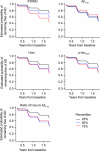MRI and CSF biomarkers in normal, MCI, and AD subjects: predicting future clinical change
- PMID: 19636049
- PMCID: PMC2715214
- DOI: 10.1212/WNL.0b013e3181af79fb
MRI and CSF biomarkers in normal, MCI, and AD subjects: predicting future clinical change
Abstract
Objective: To investigate the relationship between baseline MRI and CSF biomarkers and subsequent change in continuous measures of cognitive and functional abilities in cognitively normal (CN) subjects and patients with amnestic mild cognitive impairment (aMCI) and Alzheimer disease (AD) and to examine the ability of these biomarkers to predict time to conversion from aMCI to AD.
Methods: Data from the Alzheimer's Disease Neuroimaging Initiative, which consists of CN, aMCI, and AD cohorts with both CSF and MRI, were used. Baseline CSF (t-tau, Abeta(1-42), and p-tau(181P)) and MRI scans were obtained in 399 subjects (109 CN, 192 aMCI, 98 AD). Structural Abnormality Index (STAND) scores, which reflect the degree of AD-like features in MRI, were computed for each subject.
Results: Change on continuous measures of cognitive and functional performance was modeled as average Clinical Dementia Rating-sum of boxes and Mini-Mental State Examination scores over a 2-year period. STAND was a better predictor of subsequent cognitive/functional change than CSF biomarkers. Single-predictor Cox proportional hazard models for time to conversion from aMCI to AD showed that STAND and log (t-tau/Abeta(1-42)) were both predictive of future conversion. The age-adjusted hazard ratio for an interquartile change (95% confidence interval) of STAND was 2.6 (1.7, 4.2) and log (t-tau/Abeta(1-42)) was 2.0 (1.1, 3.4). Both MRI and CSF provided information about future cognitive change even after adjusting for baseline cognitive performance.
Conclusions: MRI and CSF provide complimentary predictive information about time to conversion from amnestic mild cognitive impairment to Alzheimer disease and combination of the 2 provides better prediction than either source alone. However, we found that MRI was a slightly better predictor of future clinical/functional decline than the CSF biomarkers tested.
Figures


Similar articles
-
MRI and CSF biomarkers in normal, MCI, and AD subjects: diagnostic discrimination and cognitive correlations.Neurology. 2009 Jul 28;73(4):287-93. doi: 10.1212/WNL.0b013e3181af79e5. Neurology. 2009. PMID: 19636048 Free PMC article.
-
Serial MRI and CSF biomarkers in normal aging, MCI, and AD.Neurology. 2010 Jul 13;75(2):143-51. doi: 10.1212/WNL.0b013e3181e7ca82. Neurology. 2010. PMID: 20625167 Free PMC article.
-
Prevalence and prognostic value of CSF markers of Alzheimer's disease pathology in patients with subjective cognitive impairment or mild cognitive impairment in the DESCRIPA study: a prospective cohort study.Lancet Neurol. 2009 Jul;8(7):619-27. doi: 10.1016/S1474-4422(09)70139-5. Epub 2009 Jun 10. Lancet Neurol. 2009. PMID: 19523877
-
Update on the biomarker core of the Alzheimer's Disease Neuroimaging Initiative subjects.Alzheimers Dement. 2010 May;6(3):230-8. doi: 10.1016/j.jalz.2010.03.008. Alzheimers Dement. 2010. PMID: 20451871 Free PMC article. Review.
-
Structural neuroimaging in the detection and prognosis of pre-clinical and early AD.Behav Neurol. 2009;21(1):3-12. doi: 10.3233/BEN-2009-0230. Behav Neurol. 2009. PMID: 19847040 Free PMC article. Review.
Cited by
-
Recent advances in neuroimaging biomarkers in geriatric psychiatry.Curr Psychiatry Rep. 2013 Jun;15(6):360. doi: 10.1007/s11920-013-0360-9. Curr Psychiatry Rep. 2013. PMID: 23636984 Free PMC article.
-
Panel of Genetic Variations as a Potential Non-invasive Biomarker for Early Diagnosis of Alzheimer's Disease.Clin Psychopharmacol Neurosci. 2011 Aug;9(2):54-66. doi: 10.9758/cpn.2011.9.2.54. Epub 2011 Aug 31. Clin Psychopharmacol Neurosci. 2011. PMID: 23429712 Free PMC article.
-
Crowdsourced estimation of cognitive decline and resilience in Alzheimer's disease.Alzheimers Dement. 2016 Jun;12(6):645-53. doi: 10.1016/j.jalz.2016.02.006. Epub 2016 Apr 11. Alzheimers Dement. 2016. PMID: 27079753 Free PMC article.
-
Short-term clinical outcomes for stages of NIA-AA preclinical Alzheimer disease.Neurology. 2012 May 15;78(20):1576-82. doi: 10.1212/WNL.0b013e3182563bbe. Epub 2012 May 2. Neurology. 2012. PMID: 22551733 Free PMC article.
-
A deep learning MRI approach outperforms other biomarkers of prodromal Alzheimer's disease.Alzheimers Res Ther. 2022 Mar 29;14(1):45. doi: 10.1186/s13195-022-00985-x. Alzheimers Res Ther. 2022. PMID: 35351193 Free PMC article.
References
-
- Price JL, Ko AI, Wade MJ, Tsou SK, McKeel DW, Morris JC. Neuron number in the entorhinal cortex and CA1 in preclinical Alzheimer disease. Arch Neurol 2001;58:1395–1402. - PubMed
-
- Tapiola T, Overmyer M, Lehtovirta M, et al. The level of cerebrospinal fluid tau correlates with neurofibrillary tangles in Alzheimer's disease. Neuroreport 1997;8:3961–3963. - PubMed
-
- Strozyk D, Blennow K, White LR, Launer LJ. CSF Abeta 42 levels correlate with amyloid-neuropathology in a population-based autopsy study. Neurology 2003;60:652–656. - PubMed
-
- Fagan AM, Roe CM, Xiong C, Mintun MA, Morris JC, Holtzman DM. Cerebrospinal fluid tau/beta-amyloid ratio as a prediction of cognitive decline in nondemented older adults. Arch Neurol 2007;64:343–349. - PubMed
Publication types
MeSH terms
Substances
Grants and funding
LinkOut - more resources
Full Text Sources
Other Literature Sources
Medical
